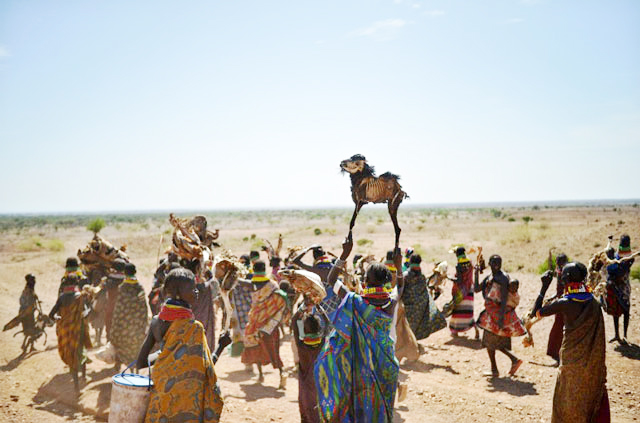
In just a few years water, oil and money would flow. Roads, schools and hospitals would follow. Turkana’s generations of poverty and neglect in Kenya’s arid north would end. But it was not to be: five years after the discovery of oil, and four since a giant aquifer was found, drought has struck again, shattering the dreams of a different future for Turkana, a bone dry region of dust and stone, home to mostly semi-nomadic livestock herders and lacking the most basic trappings of modernity. AFP PHOTO
Lokamarinyang, Kenya | AFP | In just a few years water, oil and money would flow. Roads, schools and hospitals would follow. Turkana’s generations of poverty and neglect in Kenya’s arid north would end.
But it was not to be: five years after the discovery of oil, and four since a giant aquifer was found, drought has struck again, shattering the dreams of a different future for Turkana, a bone dry region of dust and stone, home to mostly semi-nomadic livestock herders and lacking the most basic trappings of modernity.
In the remotest areas, hungry children with anaemic eyes and swollen bellies go to clinics where food and medical aid are delivered in dribs and drabs, while the carcasses of dead animals — killed by hunger and thirst — are piled outside their villages.
Water wells have run dry or brackish, often, their pumps are broken.
“All our animals are dead, and the only water to drink is dirty and makes us sick,” said Ekiru Ekitela, her neck slung with countless colourful beads. Others have resorted to eating the remains of dead animals, saying “it’s that or nothing.”
The end of March is supposed to bring rains transforming the barren plains around the village of Lokamarinyang in the Kibish region in Turkana’s far north into pasture, but so far there is none to water the desperately dry land.
To the south, in Karioreng village, Akalale Esekon tried to breast-feed her infant child, but no milk came so the baby screamed with hunger. “He sucks, thinking that something is going to come out, but when my stomach is empty, there is nothing for the child,” she said. Her four-year-old daughter Atabo lacks strength enough to cry.
Her black hair had faded to a sickly brown and her upper arms were no thicker than a ping-pong ball.
Compounding the drought is population growth in Turkana — at 6.4 percent a year, it is twice the national average — which means already scarce resources are quickly exhausted by people and their livestock.
– Promises unfulfilled –
Kenya is not Somalia or South Sudan, neighbouring nations where war and state failure help drive starvation. It is instead the region’s biggest economy and a stable if faulty democracy, but Turkana feels like another country.
“The image of Kenya as a middle income country doesn’t do justice to the reality on the ground,” said Werner Schultink, country head for the UN children’s agency, UNICEF.
Far from the agricultural south, where 90 percent of the population live, Turkana is a vast, poor region regularly ravaged by drought.
The hunger is greatest in the north. In the Kibish region, squeezed between Ethiopia and South Sudan, more than half of children aged six months to five years are suffering from acute malnutrition, according to UNICEF.
In the early part of this decade, politicians made rash promises of rapid modernisation that would consign to history decades of deliberate marginalisation, first by British colonialists and then by Kenya’s governing elite in Nairobi, who shared a disdain for the pastoralists and their way of life.
“Expectations were disproportionate,” said John Nakara, a Turkana parliamentarian. “Those changes don’t happen in five years, but in 20, at least.”
That didn’t stop the promises. An ambitious plan for roads, railways and oil pipelines crossing northern Kenya was launched with great fanfare in 2012, but has been slow coming.
Instead Turkana remains crisscrossed with dirt tracks that become impassable when it rains, and where the few sealed sections are so badly potholed that drivers prefer the dirt shoulders.
That same year, British company Tullow Oil announced the discovery of large crude reserves in Turkana.
Production is expected to begin in June, but local and national officials are still arguing over distribution of revenues and no pipeline has yet been built, meaning the oil will have to be trucked to the port of Mombasa, more than 1,000 kilometres (620 miles) away.
– Little oil, less water –
In 2013, Kenya and the UN cultural body, UNESCO, thrilled to announce the discovery of a gigantic aquifer beneath Turkana that promised irrigation and enough water for all.
The promise was of sufficient water for the whole of Kenya for 70 years, but the reality proved different: deeper underground and less pure than predicted, the aquifer has proven hard to exploit.
“The announcement was very optimistic and based on very limited information,” said Sean Avery, a Kenya-based consultant on water issues.
The picture, however, is not uniformly bleak: political devolution has handed more power, including the power to disburse funds, to local authorities since 2013, facilitating the opening of new health clinics in Turkana that cut in half the distance people have to walk to seek diagnosis or treatment.
Kenya has declared this year’s drought a “national disaster” and appealed for international aid.
Three million people are in need of emergency humanitarian assistance, and, while the response has been more effective than the last time, in 2011, still more needs to be done, aid workers say.
“In the current situation, this is clearly not enough,” said Schultink.
As the drought bites, the road ahead looks longer than ever for Turkana: some 92 percent of its 1.4 million people live below the poverty line and only a fifth know how to read and write, a figure four times lower than the national average.
Observers say education must be listed among the region’s many priorities as it holds the key to diversifying the economy and offering opportunities beyond herding livestock across an ever-drier land.
“There will be more droughts,” said Nakara. “We need to be prepared to face them.”
 The Independent Uganda: You get the Truth we Pay the Price
The Independent Uganda: You get the Truth we Pay the Price



